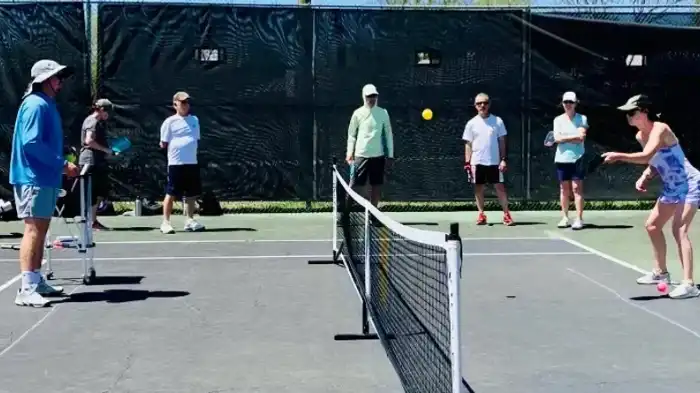Welcome to the fascinating world of pickleball, where the dimensions of the pickleball court in feet play a pivotal role in shaping the game. Understanding the nuances of pickleball court size in feet is essential to unlocking the strategy, agility, and precision required for this dynamic sport.
In this blog, we are going to discuss why the pickleball court size in feet matters, the standard pickleball court size set by the USA Pickleball Association, and standard pickleball court dimensions for different pickleball playing locations.
Why the Pickleball Court Size in Feet Matters in Pickleball?
The size of a pickleball court is crucial in the sport of pickleball for several reasons, as it directly influences the dynamics and strategies of the game. The official pickleball court size is specified by the USA Pickleball Association (USAPA), and it is important for players to adhere to these dimensions for fair and consistent gameplay. Here’s why the pickleball court size matters:
Standardization:
Having a standardized court size ensures consistency across different locations and competitions. This is essential for fair play, as players can practice and compete on courts with the same dimensions, regardless of where they are.

Strategy and Gameplay:
The size of the court affects how players move and strategize during a game. A smaller court encourages faster and more dynamic play, as players have less ground to cover. This can lead to quicker exchanges and a faster-paced game compared to sports played on larger courts.
Fitness and Endurance:
The smaller court size in pickleball means that players often engage in quick and intense rallies. This requires a combination of speed, agility, and endurance. The compact nature of the court puts a premium on efficient movement and quick decision-making.
Placement and Precision:
With a smaller court, players need to be more precise in their shots. Placement becomes crucial, and players must develop accuracy and control to effectively navigate the court and outmaneuver their opponents.
Net Play Emphasis:
Pickleball is known for its emphasis on net play, and the court size contributes to this aspect. The relatively short distance between the baseline and the net encourages players to approach the net, engage in volleys, and use dinking techniques to control the pace of the game.
Accessibility:
The smaller size of the pickleball court makes it easier for a lot of people to play, especially those who might not move really fast over large areas. That’s one big reason why pickleball is liked by people of different ages and skill levels.
What Is the Standard Pickleball Court Size?
The standard pickleball court measures 20 feet wide and 44 feet long. These dimensions are divided into two equal halves by a 34-inch high net. The court is further divided by a centerline and two sideline boundaries. Each half of the court is referred to as a “left” and a “right” service area.
There is also a non-volley zone, also known as the “kitchen,” which extends 7 feet from the net on either side. Players are not allowed to step inside this zone unless the ball bounces in it or they are volleying the ball. The non-volley zone is a critical feature of pickleball courts as it prevents players from executing aggressive shots close to the net.

Optimal Pickleball Court Dimensions for Different Locations
While the standard court size is widely accepted, there are variations in court dimensions depending on the location.
Indoor Courts
Indoor pickleball courts are usually smaller than outdoor courts due to limited space. The most common indoor court size is 20 feet wide and 40 feet long. However, some indoor facilities may have slightly different dimensions depending on the available space.
Backyard Courts
Backyard pickleball courts can be built to custom dimensions based on personal preference and available space. The recommended minimum dimensions for a backyard court are 30 feet wide and 60 feet long. However, it is important to have adequate space around the court as well, allowing players to move freely.
Tournament Courts
Tournament pickleball courts usually follow the standard dimensions of 20 feet wide and 44 feet long. These dimensions ensure consistency across different tournament venues, allowing players to adapt to the court quickly.
Frequently Asked Questions
Yes. If there is limited space available, a pickleball court can be modified to a smaller size. One-third or two-thirds of a standard court can be used for singles play, offering a more compact gameplay experience.
Yes, pickleball tournament pickleball courts typically adhere to the standard dimensions of 20 feet by 44 feet. This consistency ensures that players can adapt quickly to different tournament venues.
The pickleball court size in feet significantly impacts gameplay by promoting faster and more dynamic play. The smaller court requires quick reflexes, precise shots, and emphasizes net play, creating an environment where strategic thinking and agility are essential for success.
The non-volley zone, extending 7 feet from the net, prevents players from executing aggressive shots close to the net. It adds a strategic element to the game, encouraging players to balance offense and defense.
Conclusion
In the world of pickleball, the pickleball court size in feet serves as the invisible architect, shaping the very essence of the game. From fostering lightning-fast rallies to demanding precision in every shot, the optimal dimensions laid out by the USA Pickleball Association are the canvas upon which the sport’s strategy and excitement unfold.
Whether embracing the quick reflexes required by the compact court or reveling in the nuances of net play, players navigate a dynamic space that brings together skill, agility, and a touch of strategy. The pickleball court size in feet becomes the unspoken partner in this engaging sport, influencing every serve, volley, and match point.

